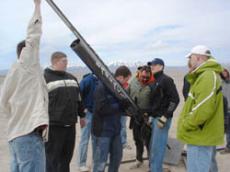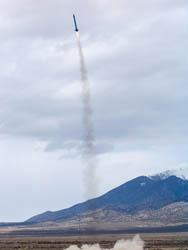Unique rocket design could lead USU team to a win
Using a design unlike any of their competitors, 15 USU engineering students will attempt to launch a rocket exactly one mile in the air to win a rocket competition sponsored by NASA.
The contest, NASA’s University Student Launch Initiative, will be held April 19 at the Marshall Space Flight Center in Hunstsville, Ala., said John Parrish, a senior in mechanical engineering and rocket team member. There will be 11 other colleges at the competition, Parrish said.
This will be the first time USU has done this competition, said Jacob Haderlie, senior in mechanical engineering and team member.
What makes USU’s rocket unique is that it has a device like an air break which will stop it from exceeding the mile mark, Haderlie said.
USU is the only school with this active control, and that is something the team wanted from the beginning, said Shannon Eilers, mechanical and aerospace engineering graduate student who worked on the project for six years. He claims to be the slave driver behind the group.
In describing the design of the rocket, team member Matthew Fifield said there is essentially a computer inside the rocket that can tell how high it is and how high it is going. It then burns the necessary energy to reach its destined height, without exceeding it. After it reaches that height, a parachute is deployed and carries the rocket safely to the ground.
In preparation for the competition, the team took the rocket to Utah Rocket Club’s Pony Express Test Site in Tooele County last Saturday. This was the first time the team had attempted to launch the rocket and will be the only time before the competition, Parrish said. The launch was successful, he said.
Haderlie said this was the first recovery of a hybrid rocket in USU history.
“It did everything we wanted it to,” Parrish said.
Throughout the year, the group has had to compile reports and has held two video conferences with NASA. NASA has been impressed with their work, Parrish said.
NASA told the team their design and reports are better than they expected from the university level, Eilers said. The team said they believe the good feedback means they will do well in the competition.
“We won’t take second place,” Eilers said.
Other team members agreed with Eilers, saying the only way they thought they wouldn’t win is if something went wrong with the rocket.
The students are part of a senior design project required for graduation. The project class is three credits and lasts both fall and spring semesters, team members said. The planning is mostly what happens in class time, but almost all of the work is done outside class, members said.
“I wouldn’t be surprised if we put in over 1,000 hours each,” Haderlie said.
After some calculation, Eilers, Parrish, Fifield and other team members agreed with Haderlie’s estimation. The team has had to do fund raising to cover all the costs associated with the rocket and its design.
Other team members include Dustin Braithwaite, Tyler DeSpain, James Kelsey, Dennis Lazaga, Mike Lewis, Nathan Lodder, Bowen Masco, Jed Peters, Michael Phillips, Jeff St. Clair, David Winget and Shane Robinson.
For more information about the team, visit http://chimaera.usu.edu/usli.
-alison.baugh@aggiemail.usu.edu

Engineering majors get ready for a test launch of a rocket they have been designign all year. On April 19, the team will travel to Alabama to compete in a NASA competition attempting to launch the rocket exactly one mile in the air. (John Parrish)

